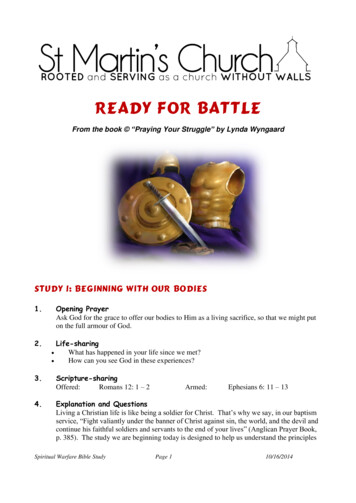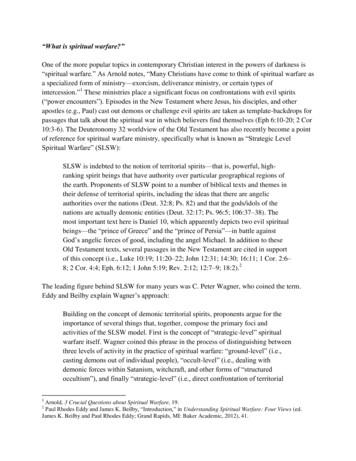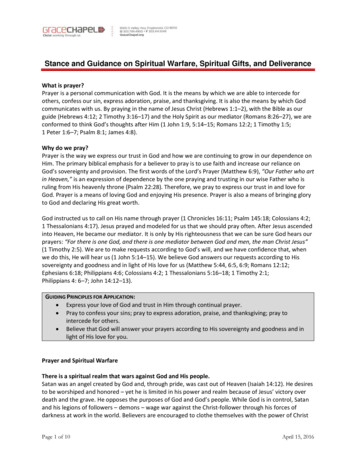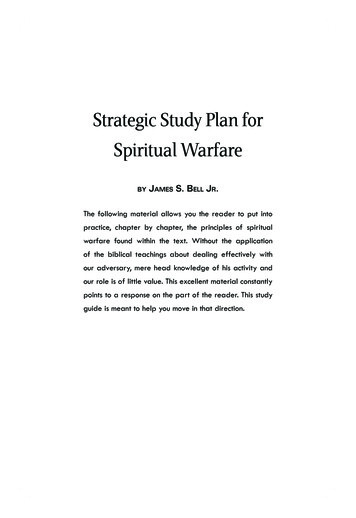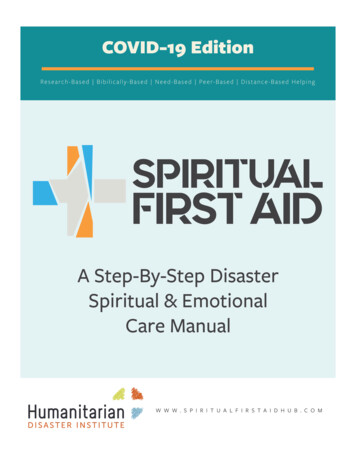
Transcription
Table of ContentsChapter 1: Introduction to Spiritual First Aid3 About Spiritual First Aid Manual Overview Who and How Spiritual First Aid Helps A Research-Based and Ministry-Based Approach toHelping Remotely While Staying at HomeChapter 2: The BLESS Method The Five Core NeedsSpiritual Care ContinuumAssess and Prioritize Unmet Core NeedsIntervene by Addressing Unmet Core NeedsChapter 3: Belonging Assessment and Intervention 36Attend to Behavioral “Red Flags”Ask Threat and Harm QuestionsAct by Referring and ReportingAnd Repeat if Warranted/PossibleChapter 7: Spiritual Assessment and Intervention 27Attend to DistressAsk Mental Health QuestionsAct by Listening and Facilitating LamentAnd Repeat if Warranted/PossibleChapter 6: Safety Assessment and Intervention 20Attend to LossesAsk Resource-Focused QuestionsAct by Connecting to Faith-Based and Community ResourcesAnd Repeat if Warranted/PossibleChapter 5: Emotional Assessment and Intervention 13Attend to Interpersonal InteractionsAsk Relationship QuestionsAct by Providing Spiritual and Social SupportAnd Repeat if Warranted/PossibleChapter 4: Livelihood Assessment and Intervention 745Attend to FaithAsk Religious and Spiritual Sensitive QuestionsAct by Encouraging Spiritual CopingAnd Repeat if Warranted/PossibleFor more resources visit spiritualfirstaidhub.comPage 2
Chapter 1. Introduction to Spiritual First AidPurpose: In this chapter you will learn what Spiritual First Aid is, what is in the manual,who it helps, how we know it helps (i.e., our research-based approach), and specific ideas forhelping remotely.“Is it not to share your food with the hungry and to provide the poorwanderer with shelter—when you see the naked, to clothe them Then youwill call, and the Lord will answer; you will cry for help, and he will say: Heream I” (Isaiah 58:7, 9).God’s blessing is being here for us each step of the way. Another blessing isthat we can participate in God’s love by being there for others in momentslike these, particularly people like those named in this verse who areespecially vulnerable.About Spiritual First AidSpiritual First Aid is an evidence-informed, peer-to-peer (i.e., naturalhelpers, lay helpers), disaster spiritual and emotional care intervention.Spiritual First Aid is the first intervention like this to have been builtfrom the ground up using both biblical wisdom and evidence-informedpsychological insights gained from years of our team’s scientific study.SPIRITUAL FIRST AIDIS THE FIRSTDISASTER, SPIRITUALAND EMOTIONALCARE INTERVENTIONTO HAVE BEEN BUILTFROM THE GROUND UPUSING BOTH BIBLICALWISDOM ANDEVIDENCE-INFORMEDPSYCHOLOGICALINSIGHTS GAINEDFROM YEARS OF OURTEAM’S SCIENTIFICSTUDY.Who Spiritual First Aid Helps You, the helper, by providing hope-filled Scripture reflections, heartfelt prayers, andpractical self-care tips in every chapter. Your family, friends, neighbors, church, and community, by equipping you withpractical helping approaches grounded in biblical wisdom. Our team’s research hasbeen adapted for the COVID-19 context (e.g., how to help remotely). Other helpers and leaders, by applying and sharing what you learn fromSpiritual First Aid. Spiritual First Aid can be used with almost anyone—regardless of their faithbackground—because its interventions can be implemented across a continuum thatranges from subtle spiritual care to obvious spiritual care (see Chapter 2).Manual OverviewFor this edition, we adapted Spiritual First Aid for COVID-19 so it can be used to assist individualsand small groups (e.g., couples, families, roommates) while physically distancing, shelteringin-place, and helping remotely (e.g., online). This manual offers a step-by-step approach tolearning and providing spiritual and emotional care for others through Spiritual First Aid’s BLESSMethod. We developed the BLESS Method to take the “guesswork” out of disaster spiritual andemotional care and make humble helping and practical presence more “concrete.”For more resources visit spiritualfirstaidhub.comPage 3
Grounded in Humility and Practical PresenceOur research has shown that humble helping and practical presence are two ways youcan be a more effective helper. Here and throughout the rest of the manual, you willfind callout boxes on how to humbly help and provide practical presence. These serve toremind you that humble helping and practical presence are central to Spiritual First Aidand to equip you to integrate both when providing Spiritual First Aid. Humility involves having an accurate view of your strengths and weaknesses. Humilityhelps you to be more others-focused. Scripture is clear that humility is essential toservice. Jesus instructs his disciples, “Anyone who wants to be first must be the verylast, and the servant of all” (Mark 9:35). He also preaches it publicly, saying, “Thegreatest among you will be your servant. For those who exalt themselves will behumbled, and those who humble themselves will be exalted” (Matthew 23:11-12). Practical presence focuses on meeting immediate practical needs of others throughsafe, supportive presence in order to facilitate holistic health. It can be difficultto provide physical presence unless you’re staying at home with others. However,providing practical presence is still possible because it is more about making anemotional and spiritual connection.Grounding your help in humility and practical presence, even when done remotely,increases your ability to hear, understand, and meet the needs of the person you areassisting. People tend to feel the most comfort when they feel their needs are perceivedaccurately and when they feel others care about them. Especially during COVID-19, whenwe cannot always provide physical presence, it becomes more crucial that we show otherswe care about what is going on in their lives with a mindset and spirit of humility andpractical presence.How Spiritual First Aid HelpsSpiritual First Aid helps people positively engage their faith in ways our research has shownreduce distress during times of adversity. Specifically, this method helps reduce distress byidentifying and providing for what we have come to call the five core needs. This is accomplishedby helping with humility and practical presence.The goal is to work within constraints and challenges caused by COVID-19as best as you can to provide practical solutions to address unmet coreneeds. Trying to fully resolve a person’s struggles during the pandemicis not a realistic goal in most cases. Though you may not be able toaddress all of a person’s unmet core needs, helping to make even smallimprovements now can lead to big improvements later. Doing so helpskeep problems from “snowballing” and getting worse in the long run.Likewise, our longitudinal studies have shown that addressing unmetcore needs early on can improve a person’s trajectory for being able topositively cope over time.For more resources visit spiritualfirstaidhub.comTHE GOAL IS TOWORK WITHINCONSTRAINTS ANDCHALLENGES CAUSEDBY COVID-19 AS BESTAS YOU CAN TOPROVIDE PRACTICALSOLUTIONS FORADDRESSING UNMETCORE NEEDS.Page 4
A Research-Based and Ministry-Based Approach to Helping Remotely WhileStaying at HomeSpiritual First Aid is based on our team’s disaster psychology of religion/spirituality research andthe disaster ministry work we have conducted around the globe over the last 15 years on: Public health emergencies such as the Ebola outbreak. Natural disasters such as Hurricanes Katrina, Michael, and Harvey. Technical disasters including the Upper Big Branch Mining Accident. Mass shootings such as the Umpqua Community College and Dallassniper tragedies. Post-conflict zones in Liberia and the Democratic Republic ofthe Congo. Humanitarian crises ranging from the Syrian refugee crisis to theBotswana drought.TAKING SMALLSTEPS TO PROVIDEPRACTICAL HELP TOOTHERS AMIDST ACRISIS LIKE COVID-19CAN MAKE A BIGDIFFERENCE.During this time, we spent the last four years field testing and refining Spiritual First Aid.Through these experiences, we have learned that disasters, including public health crises like theCOVID-19 pandemic, can have a profound negative impact on people’s well-being (i.e., spiritually,emotionally, physically) when needs are not met. More positively, we have also discovered thatfor many, religion and spirituality can help buffer against and reduce common struggles likeanxiety, depression, grief, and trauma. Through our disaster ministry work, we also experiencedfirsthand how overwhelming and difficult it can feel and be when helping.The good news is that our team’s studies show that taking small steps to practically help othersamidst a crisis like COVID-19 can make a big difference. Time and time again our researchdemonstrates that one way churches help others during difficult times is through spiritual andsocial support. Moreover, we discovered that spiritual support and social support helps peoplefind meaning, hope, and comfort in times of crisis.But herein lies the paradox: coming together physically in community is one of the mosthelpful acts a church can do to help the hurting—but in the age of COVID-19, it is thisprecise behavior that puts people at physical risk.Though research shows that physical distancing and stay-at-homepractices help protect against the outbreak of an infectious disease likeCOVID-19, studies also show that these practices are starting to takea psychological toll on people around the world. People are reportinghigher levels of anxiety, depression, and isolation, just to name a fewproblems. In addition, COVID-19 creates a host of challenging questionsabout how best to help. That is why below and throughout—why themanual provides thoughts, tips, and tools on helping remotely whilestaying at home.For more resources visit spiritualfirstaidhub.comALL YOU TRULY NEEDTO GET STARTEDHELPING IS FAITH,COMPASSION FOROTHERS, YOURNATURAL HELPINGABILITIES, AND AHEALTHY DOSE OFHUMILITY.Page 5
Helping Remotely While Staying at Home: Benefits and DrawbacksBenefits Promotes equitable service delivery. Reduces need to travel. Has been found to reduce stigma associated with getting help. Increases access to support. People using virtual support have reported feeling more empowered, as it gives peoplemore control over how they access and receive help.Drawbacks People may lack access to certain technologies, or they are not familiar with using them. Lack of physical presence may make it more difficult for some people to develop aconnection with the helper. Virtual support can also be hindered by internet connection. Delays in sounds (videoconferencing and phone). Increased possibility of external interruptions.Within our COVID-19 constraints, there are still incredible opportunities to serve other people.The BLESS Method, explained in the next chapter, offers a step-by-step approach to providingspiritual and emotional care that addresses someone’s whole range of practical needs—in atime when they may need it most.Prayer: God, give us insight into how we can serve others well in this time.For more resources visit spiritualfirstaidhub.comPage 6
Chapter 2. The BLESS MethodPurpose: In this chapter you will learn about Spiritual First Aid’s BLESS Method, five coreneeds, and the spiritual continuum.“The Lord bless you and keep you; the Lord make his face shine on you and be gracious to you; theLord turn his face toward you and give you peace” (Numbers 6:24-26).This well-known blessing in the Bible is often used to end worship services and to send people intoanother week of loving God and their neighbors. We pray this BLESS Method will bless you as youuse it to bless others by addressing their core needs in such a time as this.About the BLESS MethodThe BLESS Method is Spiritual First Aid’s assessment and intervention framework for humblyhelping and providing practical presence. BLESS represents the first letter of each of the fivecore needs (Belonging, Livelihood, Emotional, Safety, and Spiritual needs) that Spiritual First Aidwas designed to assist. Use the BLESS Method to identify people’s most pressing unmet coreneeds and then respond with the recommended paired interventions. This straightforward andintuitive four-step approach (Attend, Ask, Act, And Repeat) will help you maximize your naturalhelping skills to provide effective peer-to-peer support. Overall, the BLESS Method is designedto help you remember what and how to help others who are struggling due to COVID-19 withhumility and practical presence.Humbly Help: Begin by Examining Reasons for Wanting to HelpBefore you reach out to provide Spiritual First Aid to others, make sure you have humblyexamined your motives for wanting to help. Though not meant to be exhaustive, below area few examples of healthy and unhealthy reasons to consider:Healthy Reasons Your faith or values are motivating you to act and help. You feel moved by the stories of vulnerability, anxiety, fear, loss, and loneliness you hearfrom people around you and in the media. You are driven by compassion for those isolated by the public health crisis.Unhealthy Reasons You are motivated by a desire to meet your own needs. You want to get “in on the action” to feel powerful, or to put yourself in a “one-up”position over others. You like knowing the intimate details of other people’s lives, especially when they aregoing through hard times. You want to be known as someone who does good, important things.For more resources visit spiritualfirstaidhub.comPage 7
Provide Practical Presence: Start by “Being There”As you set out to help others, remember that practical presence often speaks moredeeply to people’s unmet core needs than any words you could say or advice you couldgive. This is not to say that you shouldn’t share your thoughts, but remember that “beingthere” (even remotely) for another person is what often helps the most. Though thepractical presence skills we will introduce throughout the manual will likely seem familiar,do not overlook them.The Five Core NeedsOur research shows that helping people address unmet needs in the wake of a public healthcrisis can help them gain a sense of meaning, feel connected, and improve resilience. Specifically,our team’s research has identified what we have come to call the five core needs most likely tobe affected by disasters like COVID-19: Emotional Needs Safety Needs Spiritual NeedsdooihLivelLivelihood NeedsEmoSPIRITUALBelSimilarly, our research suggests that it is important torecognize that these needs are interconnected. Althoughonly one of these needs is listed as spiritual, all of these needshave a spiritual component. This visual depiction of the fivecore needs in the time of crisis shows how belonging, livelihood,emotional, spiritual, and safety needs are interconnected and howthey can be understood from a spiritual perspective.Sagginon tyfeBelonging Needsnaltio Spiritual Care ContinuumWe view all the interventions taught in this manual as spiritually oriented. Faith infuses thepractice of Spiritual First Aid; it informs who you are (e.g., your worldview, beliefs, identity),gives you motivation to help (e.g., inspires you), and guides how you view and relate with others.However, different people need different things, and your spiritual and emotional care maysubtly or obviously address religion or spirituality. That is why for each core need, we suggesta range of spiritually oriented interventions, from what we refer to as subtle spiritual care toobvious spiritual care approaches.Subtle Approaches(e.g., praying silently)For more resources visit ous Approaches(e.g., praying out loud)Page 8
Subtle spiritual care approaches involve listening for cues pointing to faith-related themes.This involves skills appropriate to use for anyone, regardless of their religious background. Forinstance, you may pray silently for guidance while actively caring for a person’s need.Obvious spiritual care approaches are also provided for each recommended intervention.Examples include the initiation of religious and spiritual conversations and the use of overtlyreligious and spiritual interventions (e.g., asking a person if it is okay to pray out loud on theirbehalf). Whether your helping is more subtle or obvious, you can still integrate your faith intothe helping process through who you are, who the other person is, and the helping relationship.Assess and Prioritize Unmet Core NeedsSTEP 1. ATTENDWhat to observeStart by taking a posture of humility so you avoid assuming you knowwhat the other person needs most. Begin the conversation as younormally would while also being intentional about creating spacefor the other person to share her/his story. Use practical presence(meeting immediate practical needs via safe and supportive presence)throughout the process to attend to details discussed or observed.Pay particularly close attention to what could point to an unmetcore need. Be cautious not to interrupt; save your questions until theconversation arrives at a natural pause.Practice Tip: If you give people space to share, more often than not, themost pressing primary need will naturally begin to become apparent. Asyou listen, look for unmet needs they voluntary discuss.STEP 2. ASKWhat to prioritizeOnce the other person has had some time to talk about theirCOVID-19 experience, use open-ended questions to clarify anythingthat may have been confusing, unclear, or that may warrant furtherconversation. Don’t accidently interrogate the person or push them totalk about things they are not ready to share.Spiritual First Aid does not try to uncover deeper issues. A goodrule of thumb is to ask questions that will help you identify unmetcore needs as well as strengths and resources that can help theperson cope. Explore what you think appears to be the primary unmetcore need causing distress—then ask the person you are helping toprioritize what they think and feel is the most pressing unmet coreneed they have in that moment.Practice Tip: Work together to prioritize the most pressing primaryunmet core need the person you are helping reports—the one they findmost distressing. The goal is not to explore all five core needs in depth.Rather, the goal is to listen to where the conversation is pointing inregards to unmet needs. Then, ask the person what they consider as theirFor more resources visit spiritualfirstaidhub.comPage 9
most pressing unmet need. Next, explore further to confirm that whatwas reported seems to explain their distress. Explore further if the personyou are helping struggles to identify their primary unmet core need or ifthere seems to be a major discrepancy between what they say and whatyou have observed. Lastly, always make sure you rule out potential safetyneeds (i.e., don’t ignore “red flags”), even if another need hasbeen identified.Intervene by Addressing Unmet Core NeedsSTEP 3. ActWhat to doAfter you and the person you are assisting have identified what themost pressing primary unmet core need is in that moment, respondwith the recommended intervention we have paired with that need(see below and following chapters). Keep in mind that because ofthe nature of helping amidst COVID-19, you may only have the timeor opportunity to address a single unmet core need or be limited inopportunity for interaction. If circumstances permit, it may be possibleto address multiple unmet needs in one interaction or over multipleinteractions.Practice Tip: If the person you are helping reports an unmet safety need,this is always what you should address first—even if they report it asnot distressing.STEP 4. And Repeat Address other unmet core needs if warranted and possible. Keep inIf warranted/possiblemind, for some, their second-most pressing need may fall into thesame unmet need category, or it may fall into a different unmet needcategory. For example, someone’s two most pressing unmet needsmay both be belonging needs. Or, the person’s primary unmet needmight be a belonging need and their secondary unmet need may bea livelihood need. If more help is warranted but either it is possible inthe time you have available, exceeds your ability, or requires necessaryresources you lack, explore helping another time, connectingthe person to another helper, directing them to a faith-based orcommunity organization, or linking them to resources.Practice Tip: You may only have enough time to specifically identify andaddress one unmet core need. This is okay and is likely to be the norm—especially when helping remotely and while staying at home.For more resources visit spiritualfirstaidhub.comPage 10
Helping Remotely While Staying at Home: Sample Platforms and PracticesThese common technology tools and distancing approaches can be used to deliverSpiritual First Aid during COVID-19. Before using any of the approaches outside ofyour home, be sure to consult local, state, or federal agencies who have providedinformation, guidelines, and orders to make sure such actions are still deemed safeand appropriate. Video chatting (e.g. Facetime, Zoom, Skype, Google Hangout, Facebook Video,WhatsApp, WebEx, etc.) Phone calls Text messaging Messaging Apps (e.g. WhatsApp, KakaoTalk, WeChat, Facebook Messenger,GChat, Slack)Next are some ways that you can help in-person while still following physicaldistancing guidelines. Support others you may be sheltering-in-place with through in-person support. Talk through a closed window at least six feet away when helping neighbors, friends,and family members. Speak to neighbors while maintaining a safe distance from each other from yoursidewalk, lawn, porch, driveway, etc. Be sure to stay up-to-date about possible changes in practices deemed to be safeand recommended by local, state, and federal agencies.DENASKATTritize Unmet Cod Priore Ns aneedsesssABLESSMETHODPIntervenetoFor more resources visit spiritualfirstaidhub.comACTREEATedNeeroAddret Cess Primary UnmPage 11
How to Use the BLESS Method to Assess Unmet Core Needs and InterveneThe 5 CoreNeedsB BelongingAssess Core NeedsIntervene to AddressPrimary Unmet Core NeedsAttend(What to Observe)Ask(What to Exploreand Prioritize)Act(What to Do)And Repeat(if Warranted/Possible)RelationshipsSocial QuestionsProvide SpiritualSupportAddress SecondaryUnmet Core NeedsAddress SecondaryUnmet Core NeedsL LivelihoodHealth and FinancesResource QuestionsConnect toFaith-based,Community,and HealthcareResourcesE EmotionalMental HealthWell-BeingQuestionsFacilitate LamentAddress SecondaryUnmet Core Needs“Red Flags”(hints they areexperiencingviolence, self-harm,or suicide thoughts/behavior)Threat and HarmAssessmentQuestionsRefer and ReportAddress SecondaryUnmet Core NeedsMeaning-Making andReligious BehaviorsSpiritual Struggles,and UltimateQuestions (e.g.,about life anddeath)EncourageSpiritual CopingAddress SecondaryUnmet Core NeedsS SafetyS SpiritualPrayer: God, we ask for your blessing and that you will help us to bless others.For more resources visit spiritualfirstaidhub.comPage 12
Chapter 3. Belonging Needs Assessment andInterventionPurpose: In this chapter you will learn how to understand a person’s support system and helpconnect him or her with others who will help them navigate a time of uncertainty throughsocial and spiritual support.“Consequently you are no longer foreigners and strangers, but fellow citizens with God’s people andalso members of his household ” (Ephesians 2:19).As followers of Jesus, we are members of God’s household, it’s where we find our deepest belonging.When we are secure in belonging to this family by God’s grace, we can be sensitive to the needs ofbelonging that others have in moments of crisis.About Belonging NeedsPeople need to belong. But the methods of containing an infectious disease can cause people toexperience a loss of connection and ignite feelings of isolation. During the COVID-19 pandemic,mandated shutdowns have often abruptly disconnected a person’s usual access to their sourcesof community. Research shows that social and spiritual isolation is a strong predictor of negativemental health outcomes (e.g., depression, anxiety, suicide risk). People can cope better whenthey can seek and receive support during a time of uncertainty.Humbly Help: Treat People as the Experts of Their Own NeedsHumility helps us recognize that each of us has a lot to learn about the best way to helpothers. If we do not listen and take what people say seriously, we will not offer help thattruly addresses their needs. Treat people as the expert of their own needs. Remember that the people you are helping know their own needs better than you do. Do not assume you know what others are experiencing or what they need. Remember that helpers who think they need to be perfect are more likely tocause harm. Approach every helping interaction with humility, reminding yourself that each personyou interact with has something to teach you.Practical Presence: EngageEngagement is about connecting emotionally and spiritually with the person youare helping. Focus on being present by pushing aside internal and external distractions. Convey genuine concern and warmth to the person you are helping. Remember that each person you encounter is unique and valuable. Offer compassion, not just the appearance of compassion. Turn off the inner critic, judge, or jury when listening to other people’s stories.For more resources visit spiritualfirstaidhub.comPage 13
Needs AssessmentSTEP 1. Attend to Unmet Belonging Needs (What to Observe)As you interact with people, make sure to look for changes in the areas noted below, identifyingboth mild and significant shifts.Common Signs of COVID-19 Unmet Belonging Needs Reported infrequent contact with others. Little or no tangible or practical help provided by others and to others. Little or no emotional and spiritual support provided by others and to others. Discrepancies between the amount or type of support others are providing and whatthey feel they need. Dissatisfaction with support received. Struggles to identify how people, groups, or organizations are (or can be) serving as asource of social and/or spiritual support.STEP 2. Ask About and Prioritize Unmet Belonging Needs (What to Explore) How has COVID-19 affected your relationships with others? Family? Friends? Coworkers?Leaders and members of your church? Who has been checking in on you since the pandemic? Since the pandemic, how have you been in contact with loved ones in your life? How have people supported you emotionally since the pandemic? Spiritually? Practically? How have you experienced the various forms of help or support you have received? What hasbeen most helpful? Least helpful? How open have you been with loved ones about the level and type ofsupport you need right now? What more might you tell them aboutwhat you need? When? How might family, friends, coworkers, or others be able to support youbetter if they knew more about what is going on with you? Since the pandemic, what type of support have you been able to accessin your community? From emergency relief workers or organizations?From people in your neighborhood? From your workplace? From yourcongregation? From other faith-based organizations?OBSERVE ANDEXPLORE HOWCOVID-19 HASIMPACTED THEIRRELATIONSHIPS WITHOTHERS, WITH THEIRCONGREGATION,AND WITH GOD. How aware are you of people and organizations that are specifically supporting the needs ofthose affected by COVID-19? Which of your existing or potential sources of support do you think will help you the most inhandling the challenges you are facing because of COVID-19? Which sources of support mightbe most helpful now? Which sources of support might be really helpful later, once thistime passes?For more resources visit spiritualfirstaidhub.comPage 14
Note: If belonging needs are prioritized, still be sure to rule out possible safety needs (i.e., donot ignore “red flags”). If belonging needs are not prioritized, move on to other needs.InterventionSTEP 3. Act by Providing Spiritual Support for Primary Unmet Belonging Needs(What to Do)COVID-19 is the cause of significant belonging needs as a direct result of physical distancing,leading to feelings of loneliness and isolation. The pandemic can also cause people toexperience spiritual isolation, including feeling disconnected from God and from their placeof worship.It is unhelpful to think you know what people need most, that you “know better.” Everyoneis different. Some people want to feel surrounded by support. Others only open up in a fewvery close relationships. Some people may not seem to want any support from anyone.People also feel support in different ways. Some want a quiet listener. Others want advice.Others feel most loved by acts of caring service. Others benefit from hearing encouragingwords. Some may want spiritual support, whereas others may not. When intact, the spiritualcommunity may offer a layer of protection. Here are some ways to encourage social andspiritual support: Help people understand how the pandemic has affected their relationships and socialsupport network. Assist people in articulating what level and type of support they need right now. Encourage others to ask for the support they need. Strategize how to overcome actual or perceived barriers to social and spiritual support. Suggest that the person you are helping connect with friends, family, and neighbors viaphone or computer. If the person reports a lack of caring relationships, look for socialresources that can be accessed virtually. Help introduce the person to people or organizations that may be ableto improve their sense of belonging. Support their connections with members of their existing or potentialfaith community. Consider referring people to clergy for spiritual support or to acounselor or psychotherapist (e.g., tele-mental health services) foremotional support.COVID-19 ISTHE CAUSE OFSI
chapter 1. introduction to spiritual first aid spiritual first aid is the first disaster, spiritual and emotional care intervention to have been built from the ground up using both biblical wisdom and evidence-informed psychological insights gained from years of our team’s scienti






